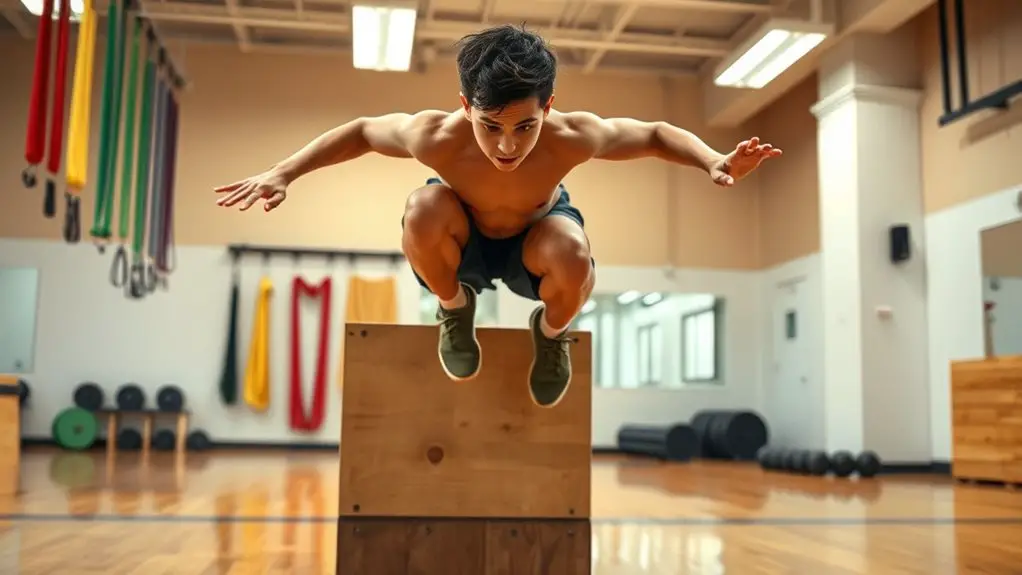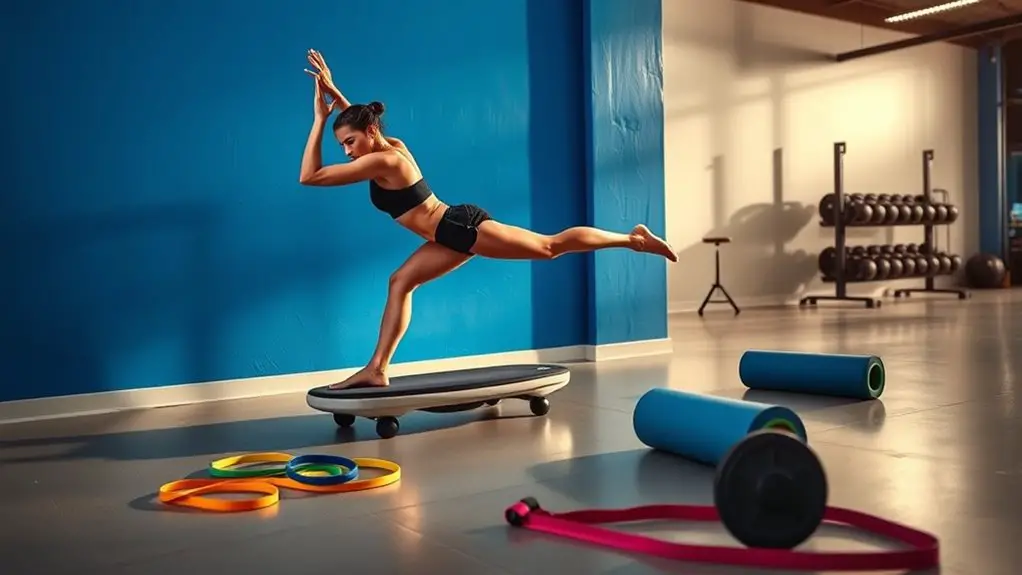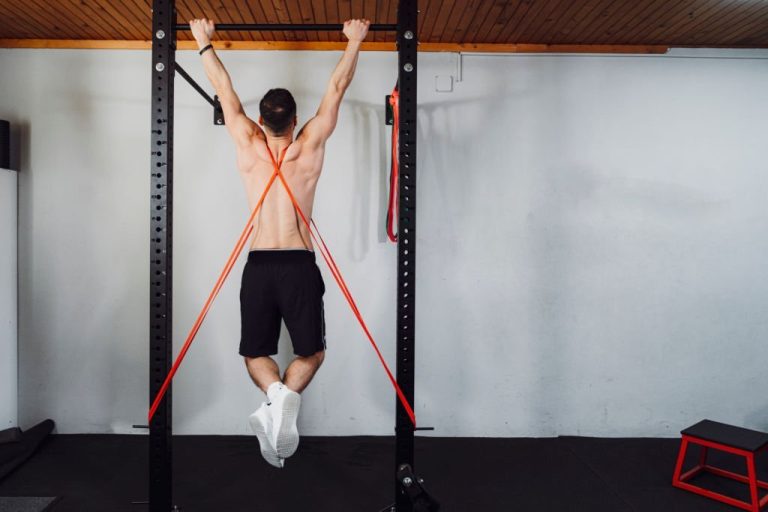Gym Workouts to Improve Your Vertical Jump

To improve your vertical jump, you need a focused gym workout that blends strength training, plyometrics, and mobility exercises. Focus on key muscle groups like your quads and calves, while incorporating explosive drills like box jumps and jump squats. Don’t forget essential warm-ups and mobility work to prevent injuries and enhance performance. Balance your routine and allow for recovery, so your muscles can thrive. Discover more strategies to elevate your jumping ability and release your potential.
Understanding the Importance of Vertical Jump Training

When you think about improving your athletic performance, understanding the importance of vertical jump training is essential. Vertical jump physiology plays a significant role in your ability to leap higher, relying on strength, power, and technique. To enhance your vertical jump, you need to focus on specific muscle groups, including your calves, quads, and glutes. Additionally, incorporating explosive energy training methods like skipping rope can provide substantial benefits to your jumping ability. Training frequency matters too; consistency is key to progress while ensuring your body has adequate time to recover. Overtraining can lead to injuries, so it’s crucial to balance intensity and rest. Incorporating rest days into your routine allows your muscles to repair and grow stronger, ultimately improving your jump height.
Essential Warm-Up Exercises for Jumping
Before you jump into your workout, it’s vital to warm up properly. Incorporating dynamic stretching techniques, plyometric drills, and mobility exercises will prepare your body for explosive movements. These essential warm-up exercises can help enhance your performance and reduce the risk of injury.
Dynamic Stretching Techniques
Dynamic stretching techniques are essential for preparing your body to jump higher and perform at your best. Incorporating dynamic warm ups into your routine helps increase blood flow and flexibility, reducing the risk of injury. Start with leg swings, gently moving your legs forward and backward; this opens up your hips. Next, try walking lunges, ensuring you maintain proper form to stretch your hip flexors and quadriceps. High knees and butt kicks also activate your muscles while improving your coordination. These stretching routines not only warm up your body but also enhance your performance. Always listen to your body and avoid overstretching, as safety is key. By including these dynamic stretches, you’ll be ready to take your jumps to the next level!
Plyometric Warm-Up Drills
To maximize your vertical jump, incorporating plyometric warm-up drills into your routine is essential. These drills help prepare your muscles and improve your jump technique while minimizing injury risk. Start with plyometric basics like jump squats and box jumps. Focus on landing softly to absorb impact, which promotes joint safety. You can also include lateral bounds to enhance stability and agility. Remember to warm up with dynamic stretches beforehand to prime your muscles. As you progress, gradually increase the intensity and height of your jumps, ensuring proper form throughout. By integrating these plyometric warm-up drills, you’ll not only boost your vertical jump but also create a solid foundation for your overall performance. Stay safe and enjoy the process!
Mobility Exercises Importance
While many focus on strength and power for improving vertical jump, mobility exercises play an essential role in your warm-up routine. These exercises enhance your mobility benefits, ensuring your muscles and joints are ready for explosive movements. By incorporating dynamic stretches and mobility drills, you can improve your range of motion, which directly impacts your jumping ability.
Additionally, focusing on joint health helps prevent injuries during intense workouts. Properly warmed-up joints are less susceptible to strains and sprains, allowing you to train harder and more effectively. So, don’t skip mobility work in your warm-up; it’s vital for maximizing your vertical jump while keeping your body safe and healthy. Prioritize these exercises, and you’ll see improvements in both performance and longevity in your training.
Strength Training Exercises to Enhance Power
To improve your vertical jump, focusing on strength training is essential. You’ll want to target key muscle groups through compound movements, which build overall power. Incorporating plyometric exercises will also help you develop explosive strength, giving you that extra boost. Including exercises like the Half-Kneeling Cable Press can significantly enhance your core engagement and stability, crucial for effective jumping.
Key Muscle Groups
Building explosive power for your vertical jump hinges on targeting specific muscle groups through strength training. Focus on developing quadriceps strength to propel yourself upward, while calf engagement helps you generate force during takeoff. Don’t overlook hamstring activation, as it stabilizes your legs and aids in a powerful jump. Core stability is essential for maintaining balance and control throughout your movement. Glute power contributes greatly to your overall strength, allowing for a more explosive lift. Additionally, incorporating ankle flexibility and hip mobility exercises can enhance your range of motion, further improving your jump. Finally, prioritize muscle endurance to sustain your performance during repeated jumps. By targeting these key muscle groups, you’ll build a solid foundation for an impressive vertical leap.
Compound Movements
Incorporating compound movements into your strength training routine is essential for enhancing vertical jump power. These compound exercises engage multiple muscle groups simultaneously, making your workouts more efficient and effective. When performed safely, they build strength and improve coordination.
Here’s a quick reference table of effective compound exercises for weight training:
| Exercise | Muscles Targeted | Safety Tips |
|---|---|---|
| Squats | Quads, hamstrings, glutes | Maintain a straight back |
| Deadlifts | Glutes, hamstrings, core | Keep weights close to body |
| Bench Press | Chest, shoulders, triceps | Use a spotter for safety |
| Overhead Press | Shoulders, core | Stand firm, avoid arching |
Plyometric Exercises
While compound movements lay a strong foundation for strength, plyometric exercises take your vertical jump training to the next level by focusing on explosive power. Incorporating exercises like box jumps, jump squats, and depth jumps can greatly enhance your ability to generate force quickly. Make sure you warm up properly to prevent injuries, and start with lower heights or simpler variations if you’re new to these movements. Hurdle hops and bounding exercises are excellent for improving coordination and agility, while single leg jumps can help develop strength in each leg individually. Always prioritize form over speed, and give yourself adequate rest between sets to maximize your performance and minimize the risk of injury. With consistency, you’ll notice improvements in your vertical jump.
Plyometric Drills for Explosive Jumping
To maximize your vertical jump, plyometric drills are essential, as they enhance explosive power and improve overall athletic performance. Incorporating exercises like box jumps and jump squats into your routine can notably boost your jumping ability. When performing box jumps, make certain you’re using a stable surface, and always land softly to reduce the risk of injury. Start with a height that challenges you but allows for safe landings.
Jump squats are another effective drill; focus on a controlled movement. Begin in a squat position, then explode upward, landing back softly into the squat. Remember to maintain proper form throughout to protect your knees and lower back.
Start with a few sets of each exercise, gradually increasing intensity as your strength and confidence grow. Prioritize safety, and listen to your body—if something doesn’t feel right, don’t hesitate to adjust your approach.
Flexibility and Mobility Work for Better Performance

Improving your vertical jump isn’t just about strength and power; flexibility and mobility play an essential role in your overall performance. Incorporating flexibility benefits into your routine can enhance your jumping ability while reducing the risk of injury. Here are some effective mobility routines you can try:
- Dynamic Stretching: Engage in leg swings and arm circles to warm up your muscles.
- Hip Openers: Perform lunges with a twist to improve hip flexibility, vital for better jump mechanics.
- Ankle Mobility: Include calf stretches and ankle circles to guarantee your lower body can generate maximum force.
- Foam Rolling: Use a foam roller on your legs and back to release tight muscles and improve blood flow.
Creating a Balanced Workout Routine for Vertical Jump Improvement
Flexibility and mobility routines set a solid foundation for enhancing your vertical jump, but a well-rounded workout plan is key to achieving significant gains. To create an effective routine, focus on a mix of strength training, plyometrics, and agility drills. Aim for a workout frequency of at least three to four times a week, allowing your muscles time to recover.
Incorporate exercises like squats, lunges, and box jumps to build strength and explosive power. Don’t forget to prioritize your nutrition strategies—fueling your body with the right nutrients can boost performance and recovery. Emphasize lean proteins, whole grains, and plenty of fruits and vegetables to support your training efforts.
Listen to your body, and adjust your routine as needed to avoid injury. With a balanced approach and commitment to both training and nutrition, you’ll see improvements in your vertical jump in no time.
Frequently Asked Questions
How Often Should I Train for Vertical Jump Improvement?
When you’re considering how often to train for improvement, it’s important to balance training frequency with recovery periods. Training three to four times a week can be effective, but listen to your body. If you’re feeling fatigued or sore, allow yourself adequate recovery to prevent injuries. Incorporating rest days into your routine helps your muscles repair and grow stronger, ensuring you’re prepared for your next training session. Prioritize safety while aiming for progress.
What Should I Eat to Support My Jump Training?
To support your jump training, focus on nutrition timing and meal planning. Prioritize lean proteins for muscle recovery, complex carbs for sustained energy, and healthy fats for overall health. Eating a balanced meal before and after workouts can optimize your performance and recovery. Stay hydrated and consider nutrient-dense snacks between meals. By fueling your body properly, you’ll enhance your training and keep yourself safe from injury while improving your athletic performance.
Can I Improve My Vertical Jump Without Weights?
Absolutely, you can improve your vertical jump without weights! Focusing on plyometric exercises like jump squats and box jumps will help enhance your explosiveness. Incorporating bodyweight routines, such as lunges and calf raises, can also build strength and stability. Just make sure to warm up properly and listen to your body to avoid injury. With consistent effort and the right techniques, you’ll see progress in your jumping ability over time.
How Long Until I See Results From My Training?
When you start training, it’s natural to wonder how long it’ll take to see results. Typically, with consistent effort and proper progress tracking, you might notice improvements in a few weeks. However, everyone’s body responds differently, so patience is key. Make sure you’re prioritizing safety and listening to your body. Stay consistent with your training, and you’ll likely achieve your goals without risking injury. Remember, slow and steady wins the race!
Are There Any Age Restrictions for Vertical Jump Training?
While there’s no strict age restriction for vertical jump training, age considerations are important. You wouldn’t want to push a young athlete too hard, as their bodies are still developing. Youth training should focus on building a solid foundation, emphasizing proper technique and safety. For older athletes, training can be more intense, but listening to your body is key. Remember, progress takes time, and safety should always come first, regardless of age.





